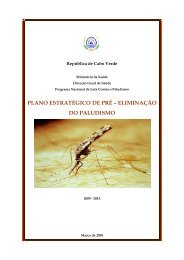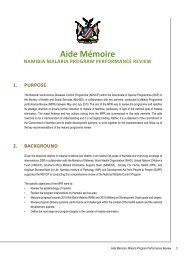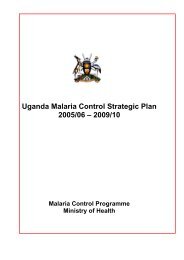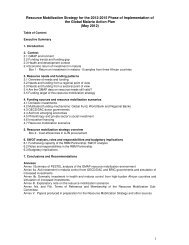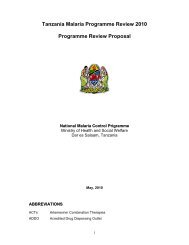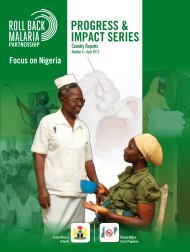Progress & ImPact serIes - Roll Back Malaria - World Health ...
Progress & ImPact serIes - Roll Back Malaria - World Health ...
Progress & ImPact serIes - Roll Back Malaria - World Health ...
Create successful ePaper yourself
Turn your PDF publications into a flip-book with our unique Google optimized e-Paper software.
Different products on the market have different combinations of antibodies that can detect the above<br />
antigens. RDTs that detect both falciparum-specific and non-falciparum (or pan-specific) target<br />
antigens are commonly called “combination” or “combo” tests. The most common formats of RDT<br />
products are a plastic cassette and dipsticks; cassettes tend to be simpler to use than dipsticks and<br />
have been deployed on a wider scale.<br />
WHO has published the results of RDT performance evaluations against panels of wild-type parasites<br />
diluted at specific densities and assessed for stability at high temperatures and ease of use (7). The<br />
evaluations show wide variation in the performance of different products and procurement should be<br />
undertaken in the light of good evidence. An interactive guide designed to help national malaria control<br />
programmes select malaria RDTs with specific performance characteristics is available (8). Training,<br />
supervision, and performance evaluations of health workers using RDTs are also a necessary part of<br />
RDT programmes.<br />
Polymerase chain reaction (PCR) tests: The new method of PCR, which is more sensitive than light<br />
microscopy or RDTs, is being used for research and field studies for detecting submicroscopic<br />
infections, especially with rare species (P. malariae, P. ovale, and P. knowlesi), mixed infections, and<br />
low-density infections. In Cambodia, for example, in a national survey in 2007 in which the populations<br />
of 76 villages were screened, 13 more villages with malaria cases were identified with PCR than with<br />
microscopy (9). During screening and treatment in Pailin, Cambodia, in 2008–2009, use of PCR with<br />
feedback and treatment of positive cases made it possible to identify and treat 86 asymptomatic<br />
carriers (P. vivax in most cases) among the 928 people screened, instead of 6 identified and treated<br />
when only RDTs were used (10).<br />
The relation between the incidence of symptomatic malaria and the prevalence of asymptomatic<br />
infections in a population (called the “reservoir”) is not fully understood. It depends partly on the<br />
prevalence of low-density infections: the lower the overall parasite prevalence in a population, the<br />
more additional infections will be found by PCR than by microscopy (11). It also depends on the speed<br />
at which malaria transmission decreases: when the decrease in transmission is more rapid than<br />
loss of immunity in a population the reservoir of asymptomatic carriers can be significant and mass<br />
screening is potentially appropriate. For example, in Cambodia microscopy suggested a 3% prevalence<br />
rate whereas PCR resulted in a prevalence rate of 7%. When transmission has decreased over many<br />
years—for instance in the Brazilian mountains outside of Amazonia where there is a prevalence rate<br />
of 0% by microscopy, 0.5% by PCR for P. falciparum, and 1.5% by PCR for P. vivax (12), or in two districts<br />
in Sri Lanka with a prevalence rate of 0% by PCR in two districts (13)—most people with parasitaemia<br />
are symptomatic because they have no immunity and the reservoir is minimal. In these situations mass<br />
screening will probably not be cost-effective.<br />
The potential programme value of detecting low-density infections that are microscopy-negative but<br />
PCR-positive is unclear.<br />
DEFEATING MALARIA IN ASIA, THE PACIFIC, AMERICAS, MIDDLE EAST AND EuROPE<br />
25




